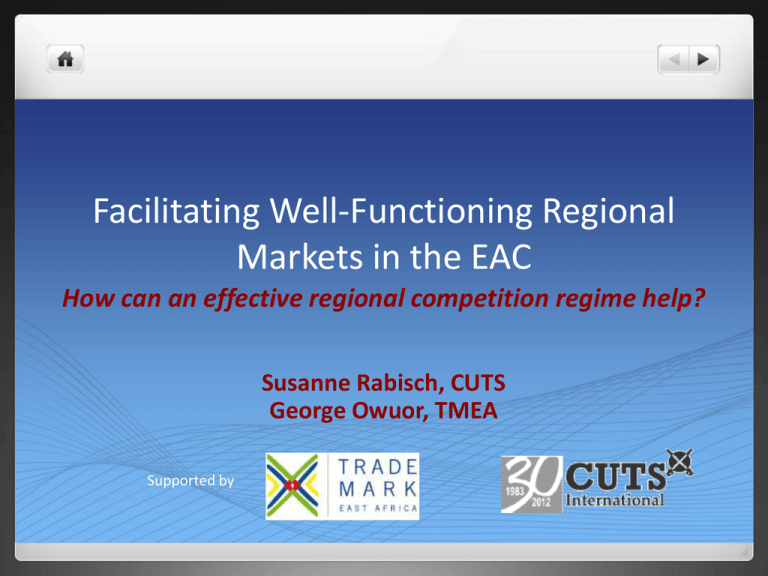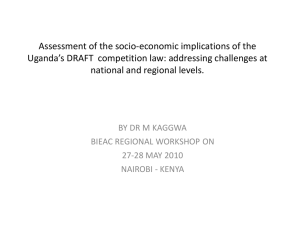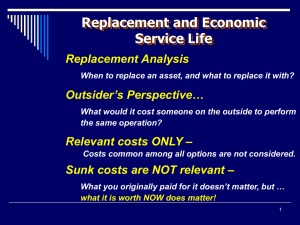Facilitating Well-Functioning Regional Markets in the EAC
advertisement

Facilitating Well-Functioning Regional Markets in the EAC How can an effective regional competition regime help? Susanne Rabisch, CUTS George Owuor, TMEA Supported by 2 Outline 1. Introduction 2. National and Regional Competition Regimes in the EAC 3. Progress and Challenges in the Implementation of EAC Competition Law 4. Cross-border Competition Concerns in the EAC - an overview 5. Conclusion and Suggested Way forward 1.Introduction With the enactment of the EAC Competition Act in 2006 foundation for a regional competition regime has been laid However, implementation of the EAC Competition Act has not seen much progress in spite of its relevance and need CUTS implementing a project to contribute to the process of harmonising the national and regional competition laws in the EAC region (EACOMP project) This presentation will outline some of the research findings and suggested way forward 3 1. Introduction: The Concept of Competitiveness Competitiveness Trade Competitiveness Export Competiveness Export Structure Trade performance 4 1. Introduction: Export Competitiveness “Export competitiveness is the ability of the producers to sell goods in the global market place at a price, quality and timeliness comparable to competing foreign producers.” 5 1. Introduction: How does competition help? Low Entry Barriers Increase in efficiency Investor Confidence 6 1. Introduction: Practical Examples Logistics Industry Financial Industry 7 8 2.National and Regional Competition Regimes in the EAC 2.1. Competition Laws, Regulations & Institutions Competition Act Competition Competition Regulations Department in Ministry of Trade /EAC Sec. Independent Competition Competition Tribunal Authority Tanzania ✔ ✔ - ✔ ✔ Kenya ✔ ✔ - ✔ ✖ Rwanda ✔ ✖ ✔ ✖ ✖ Burundi ✔ ✖ ✔ ✖ ✖ Uganda ✖ ✖ ✖ ✖ ✖ EAC ✔ ✔ ✔ ✖ ✖ 9 2.2. Readiness for Implementation of EAC Competition Act (relevant national policies/laws) Effective enforcement of a competition regime on the national and regional level requires certain flanking policies and laws to be aligned with the “spirit of competition” From a regional competition perspective it is therefore critical to review a number of related policies and laws in the EAC countries. Industrial Policy National Procurement Trade and Investment Labour Competition policy and national laws This will be necessary to assess whether they act as “enablers of a competitive regional market” and determine any needed amendments to the national or regional law 10 11 3. Progress and Challenges in the Implementation of EAC Competition Law 3.1.Progress in the Implementation of the EAC Competition Act, 2006 Progress and Current Status EAC Competition Regulations adopted in 2010 Section 38 of Act amended to allow appointment of 5 Commissioners Jun. 2013 - Sectoral Council on Trade, Industry, Finance & Investment (SCTIFI) adopted Roadmap for establishment of EAC Competition Authority May 2014 - SCTIFI directed EAC Sectt. to establish the EACCA in FY 2014-15. EACCA to be housed under EAC Department of Trade, Industry, Finance & Investment Challenges and Hindrances Harmonization of competition laws not done, as anticipated by Sept.2013 (Roadmap) Officer responsible for competition issues at the Secretariat was vacant for a long period Difference in the levels of economic development and institutional/legal readiness to implement EAC Act Varying levels of national capacity for implementation No agreement on implementing EAC Competition Act, without national laws/insitutions in place in all members 12 3.2. Stakeholder Views: Challenges in the Implementation of EAC Comp. Law Institutional Challenges: - Competition Authorities are not yet established in all EAC member states - Capacity of national institutions to fulfill role according to the EAC Act is not given - Resources for the establishment of EAC Comp. Authority are to be provided by members National Vs EAC Competition Laws - National legal framework needs to be in alignment with EAC Act - not yet undertaken - Different levels of national economic development and quest for protectionism - Amendments to the EAC Competition Act in this regard have been delayed - Political Economy Challenges - Lack of political will to advance the implementation of EAC Comp. Act Vested interests - National reluctance for regional supervision of national procurement and industrial policy 13 14 4. Cross-Border Competition Concerns in the EAC 4.1. Possible factors causing competition concerns in the EAC Inland transport costs are very high, thus reducing the ability of regional firms to exert competitive pressures on local dominant firms Exchange rate volatilities within the EAC region has slowed down market entry and exit in the face of sunk costs related to currency movements therefore incentivizing anticompetitive behaviour among dominant firms The EAC region is characterized by firms with significant market power, dominant firms are able to operate outside competition pressures, abuse their dominant position and keep prices high 15 4.1.Possible factors causing competition concerns in the EAC (Contd.) The existence of Non-Tariff Barriers (NTBs) in the EAC region are a regional competition concern as they restrict the free movement of goods in response to supply and demand Customs administrative entry and passage procedures Government participation in trade and restrictive practices tolerated by it Distribution Restrictions Specific limitations Technical barriers to trade and sanitary and phyto-sanitary measures (World Bank 2012) The operation of MNCs in the regional EAC market pose threat to local firms and consumers dominance by distribution arrangements through local subsidiaries or distributor firms (esp. exclusive distributorship = vertical arrangement) 16 4.2. Common Types of Cross-Border Anticompetitive Practices Anticompeti tive Mergers and Acquisitions Abuse of dominance Market sharing 17 4.3. Some Red-Flags in Key Sectors in the EAC Breweries: leading players such as MNCs have been engaging in different tactics aimed at increasing their market shares at the expense of their rivals, e.g. shareholding in dominant firms in their won markets linkages among players in different markets in the EAC Cement: Subsidiary companies of MNCs with presence in more than one country in the EAC have been engaged in fierce price competition which can easily breed anticompetitive tendencies 18 4.3. Some Red-Flags in Key Sectors in the EAC (Contd.) Banking: Foreign-owned banks in general have a strong presence in the EAC banking sector, controlling more than half the total assets of the banking sectors in Uganda (79%), Rwanda (54%), Tanzania (51%), Kenya (45%) and Burundi (41%) and have a natural advantage over local banks (Sanya and Gaertner, 2012) Kenyan banks are a dominant force in the region – 19 of top-30 in the region. Kenya's network is most formidable Alleged collusion between banks through concentrated market structure (interest) Telecommunication: Negotiations among national telcom providers for borderless roaming are beneficial for consumer, however, may be breeding ground for collusive practices among national providers across borders including on tariff charges 19 5. Possible Ways Forward Political will must be created to ensure the motivation of stakeholders to prioritize implementation of the regional and national competition laws The general public/consumers and the private sector need to be educated and made aware of the benefits that EAC and national competition regimes foster sensitize policy makers in partner states who do not have competition regulations/institutions in place to appreciate the benefits of national and regional level competition policy and law public/consumer support can be generated to influence the political process in the advancement of the operationalization of the law 20 5. Possible Ways Forward Capacity building of regional and national structures to implement the the EAC competition law to address anticompetitive practices in the region effectively EAC Partner States should implement the decisions of the SCTIFI of June 2013 urging Partner States that have not enacted competition laws and/or constituted Competition Authorities to do so. The Partner States should harmonize their respective national laws with the regional law, and possible amendments to the EAC Act have to be made a priority on the summit level 21 6. Planned Project Advocacy Activities: “Accelerating the Implementation of EAC Competition Policy and Law” National Advocacy and Training Workshops (October/November 2014) Dissemination of research findings on “State of Play of National Competition Reforms” Presentation of analysis of the alignment of national competition legislation and EAC competition law, challenges and solutions Presentation of findings on Cross-Border Competition Concerns in the EAC Training: Fundamentals of anti-competitive practices, strategies to address crossborder competition concerns, Advocacy strategies Regional Advocacy Workshop (March 2015, Arusha) Presentation of research findings of EAC Synthesis Report on State of Implementation of EAC Competition Law EAC secretariat presentation on current state of EAC competition law implementation and the way forward International experience: regional competition regimes If interested to attend a workshops please email: sur@cuts.org 22 7. Endpoints Many potentially anticompetitive practices are going unchecked due to the absence of an overall regional regulator to deal with cross-border competition issues Leaving weaker market players and consumers exposed to unfair business conduct by dominant firms (private or public sector owned) National representatives at the EAC level must prioritize the implementation of the EAC Competition Act 2006 in order to promote a level-playing ground to promote fair competition and consumer welfare Fair competition in the region is expected to lead to better access to goods and services, lower prices, better quality and private sector growth 23 24 Thank you









